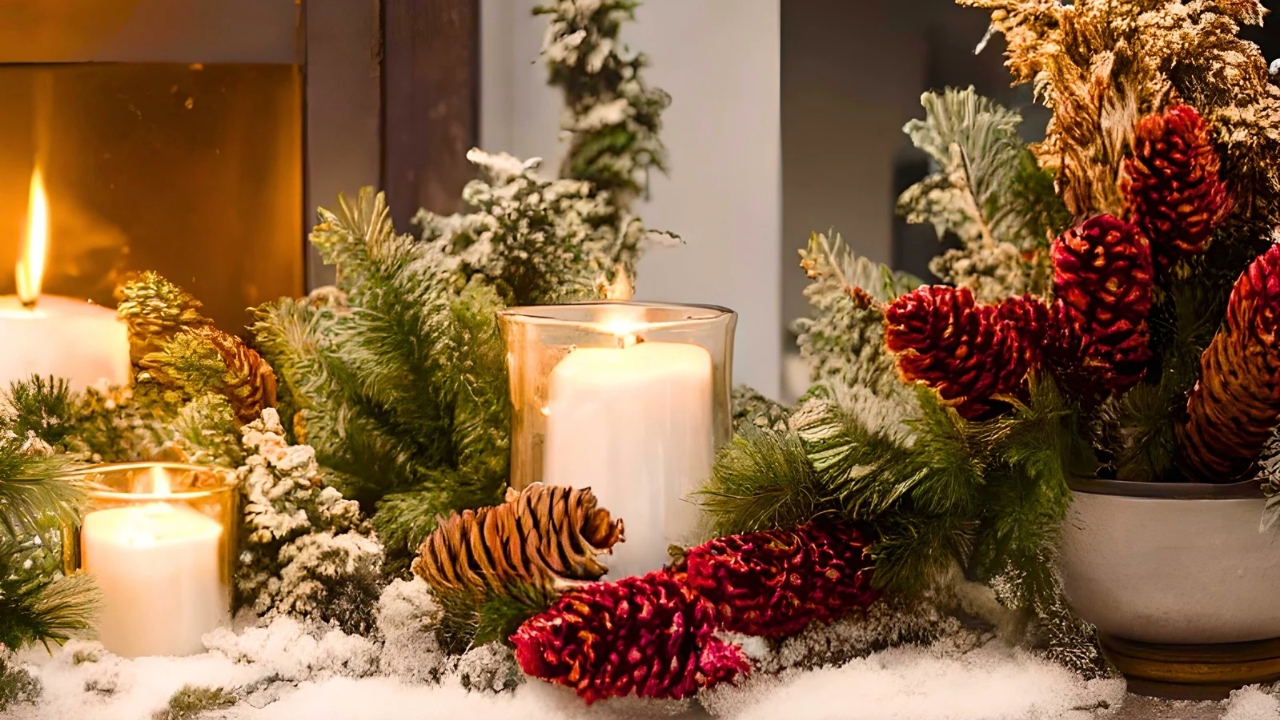Winter gardening is necessary to keep outdoor areas interesting and beautiful throughout the year. By adding winter-blooming plants, you may transform the winter months into vibrant displays of color and vitality.
The challenging element is locating plants that can thrive in frigid climates and bring color to bleak surroundings.
Even though it defies the season, you may create a cheery landscape with evergreen foliage by choosing the correct winter-blooming plants.
Winter Jasmine
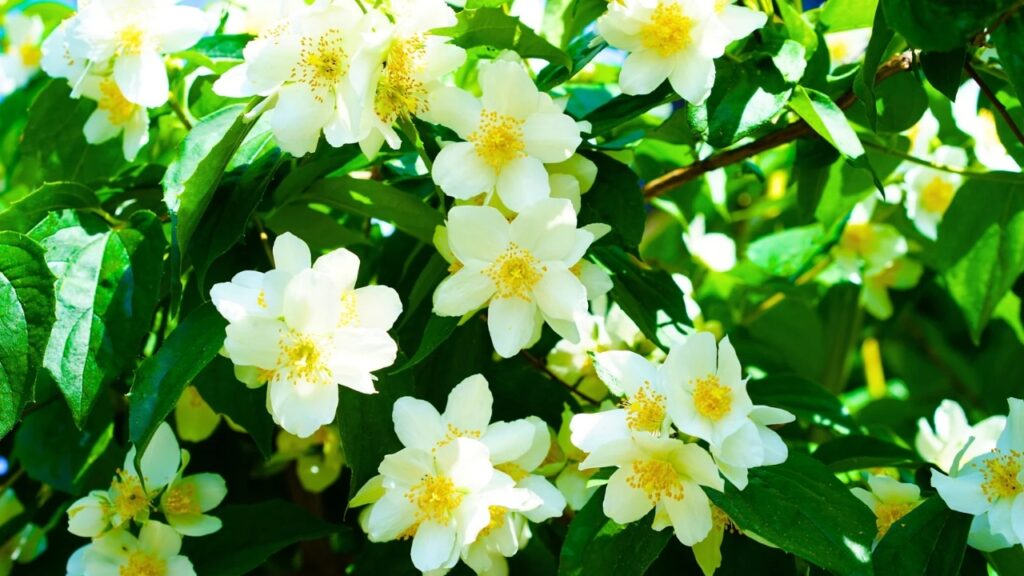
Winter jasmine is a deciduous shrub that is valued for its bright yellow blossoms that appear in late winter or early spring.
These flowers provide the garden early color and create a striking contrast with the plant’s bare green stalks, despite the fact that they are not scented.
Full sun encourages the finest flowering, and sunny to somewhat shaded locations with well-drained soil are perfect for winter jasmine growth. It’s important to water the soil frequently, particularly during dry seasons, but avoid overwatering.
Air circulation is encouraged by thinning out crowded areas and trimming damaged stems to the base. To keep the ideal shape and encourage new development, pruning is required.
Winter jasmine often benefits from support in the shape of a wall, fence, or trellis since its long stems can be trained to create a cascade look.
When planted against a wall or over a trellis, this versatile plant gives winter interest and early color. It also looks nice combined in with other evergreen shrubs and early-blooming plants. It also looks good as a ground cover on banks or slopes.
Hellebore (Helleborus Spp.)
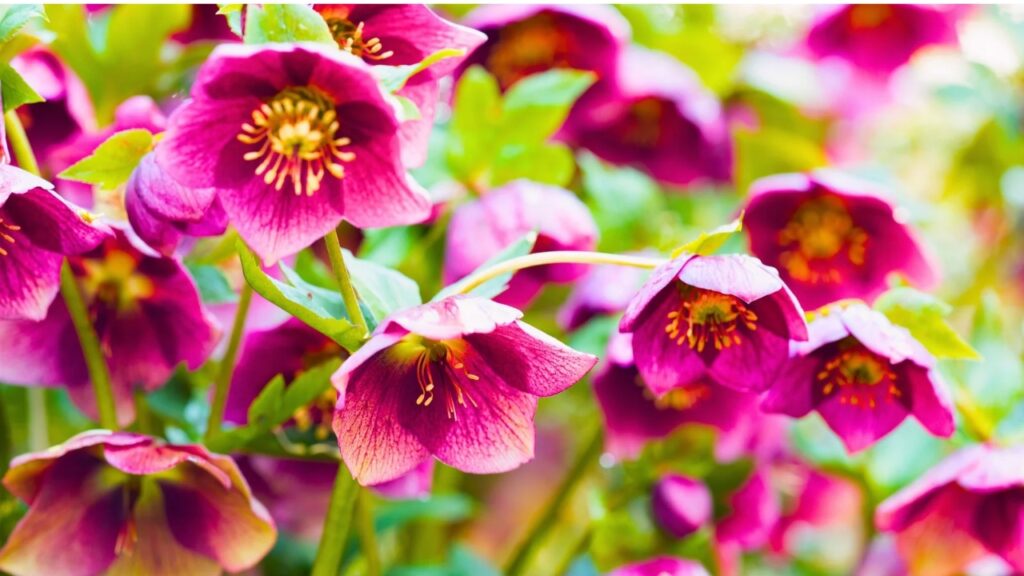
Hardy perennials, hellebores—also called “Christmas Roses” or “Lenten Roses”—bloom from late winter until early spring. They belong to several species and hybrid variations and appear in a variety of hues.
Light, frequent watering, and rich, well-drained soil with a high organic matter content are all ideal for hellebores.
Because they thrive in partial to full shade, they are perfect for woodland gardening or planting under trees and bushes.
Snowdrop
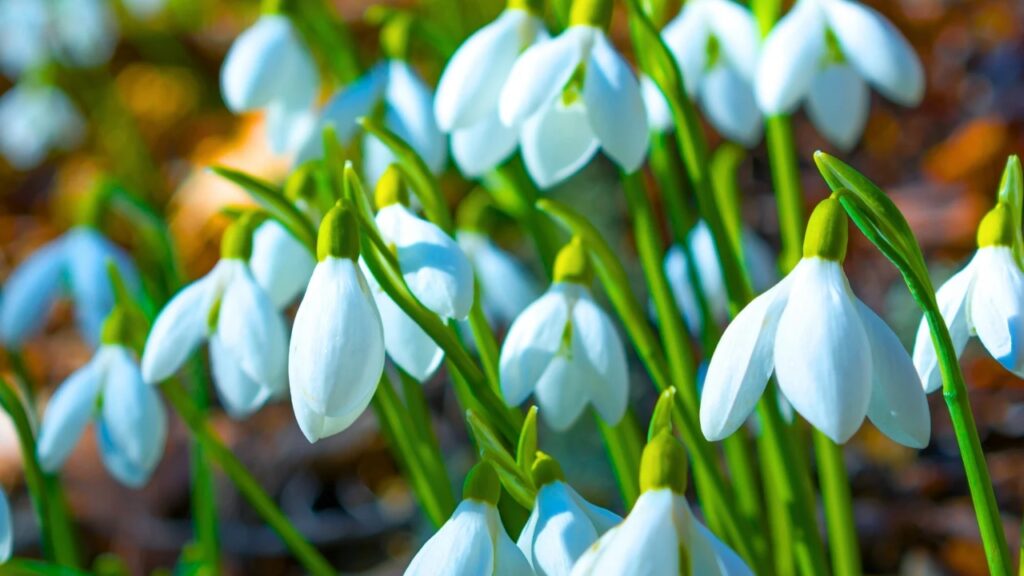
The tiny, fragile bulbs known as snowdrops bloom early in the winter and produce white, nodding blooms that persist for a few weeks.
Their modest stature (about 4-6 inches) and elegant, arching blossoms make them attractive for winter gardens. They demand well-drained, organic soil and should be planted in the fall in cooler climes.
Although they can withstand full sun or moderate shade, snowdrops prefer a location that receives sunlight in the winter and shade in the summer, like under deciduous trees. Place snowdrop bulbs two to three inches deep, three inches apart, with pointed ends facing up.
They can be placed along walks and borders for a striking show or in groups for a more realistic look.
Snowdrops are perfect for early winter blossoms in colder climates since they can tolerate below-freezing temperatures and snow cover. A bright, colorful winter garden can be created by combining them with other winter plants.
Winter Heather (Erica Cornea)
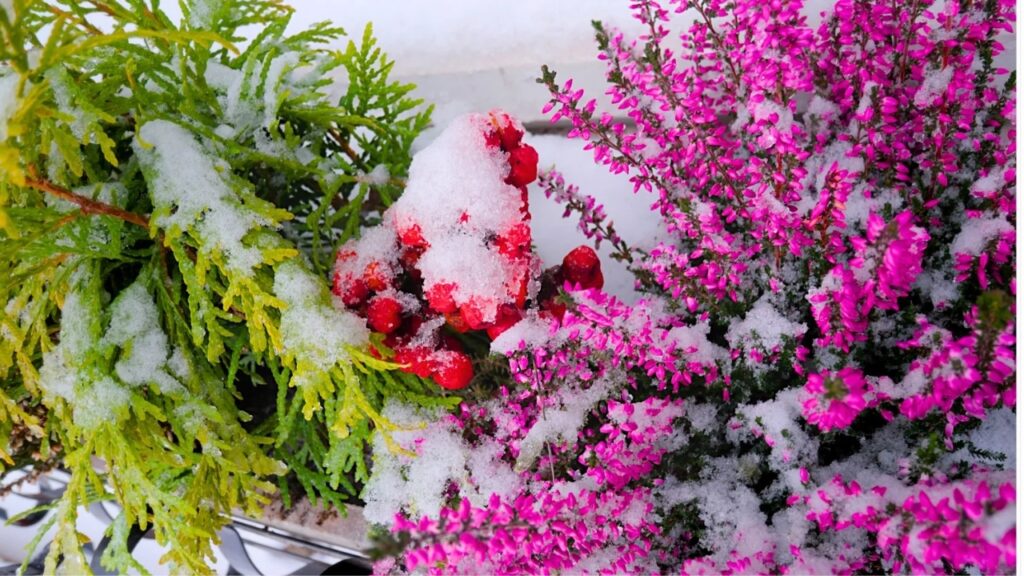
Winter Heather is a low-growing evergreen shrub that blooms from late winter to early spring. It is also referred to as “Spring Heath” or Erica cornea.
Its needle-like leaves create a thick mat, and common variations include “Springwood White” and “King George.”
“Winter Beauty” and “Myretoun Ruby.”
For winter hedging, it favors acidic soils over neutral ones, but adequate drainage is required to prevent root rot. Winter Heather enjoys full sun to light shade and requires frequent watering.
After flowering, softly trim the plants to keep their shape. Apply a balanced, slow-releasing fertilizer in the early spring and mulch with bark or pine needles to promote healthy development.
Winter Heather is hardy in USDA zones 5-7, making it appropriate for colder areas. In addition to providing height, a stunning bloom form, and layers of color and texture when paired with other plants, its blossoms are resilient and resistant to snow and frost.
Winter Heather helps minimize erosion and adds color to hard-to-grow locations by bringing color and texture to slopes, banks, borders, rock gardens, and containers.
Camellia (Camellia Japonica)
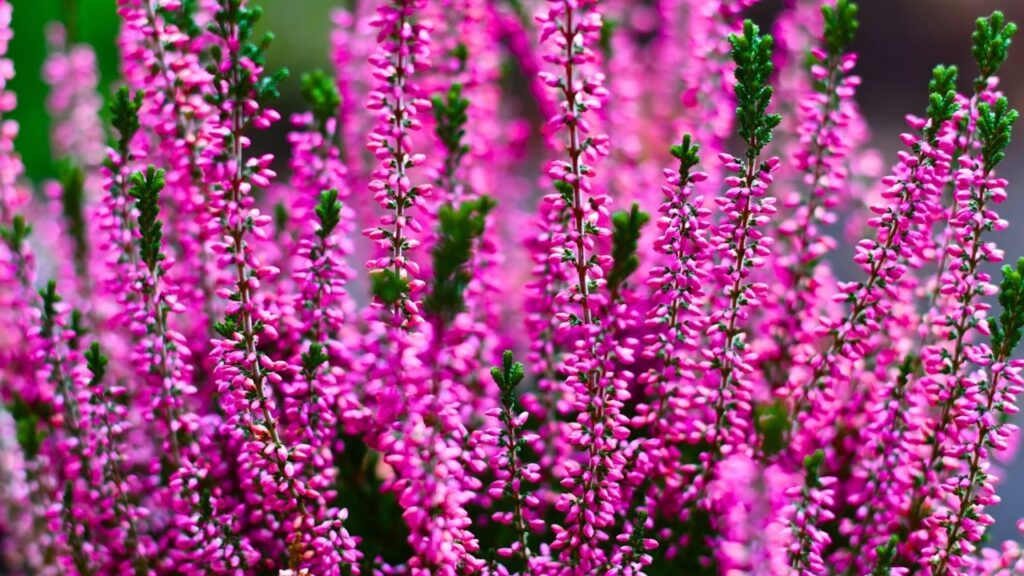
Camellias are valued for their glossy, dark green leaves and beautiful, rose-like blossoms that occur in late fall or early spring. They can be tiny trees or evergreen shrubs. Camellia sasanqua, which flowers earlier; Camellia japonica, which blooms in pink, white, and red; and Camellia x Williamson, a hybrid of C. japonica and C. saluenensis, which is valued for its extended flowering time and hardiness, are some of the most well-known species.
Guidelines for caring for camellias include maintaining an acidic soil pH of 5.5 to 6.5 and ensuring proper drainage to prevent root rot.
They favor some shade, particularly in areas where summers are scorching. Regular watering is necessary, but not so much that they get soggy.
To shape the plant and remove any dead or damaged branches, it should be lightly clipped after blooming. In the spring and again in the middle of the summer, fertilization should be performed.
Camellias provide excellent focal pieces next to patios, walkways, and entrances and can lend winter appeal to garden design. They also thrive in large containers, mixed shrub borders, woodland gardens, and hedges.
Camellias may lend bright color and intrigue to your winter garden when most other plants are dormant, provided you choose the right type and provide the right care.
Witch Hazel
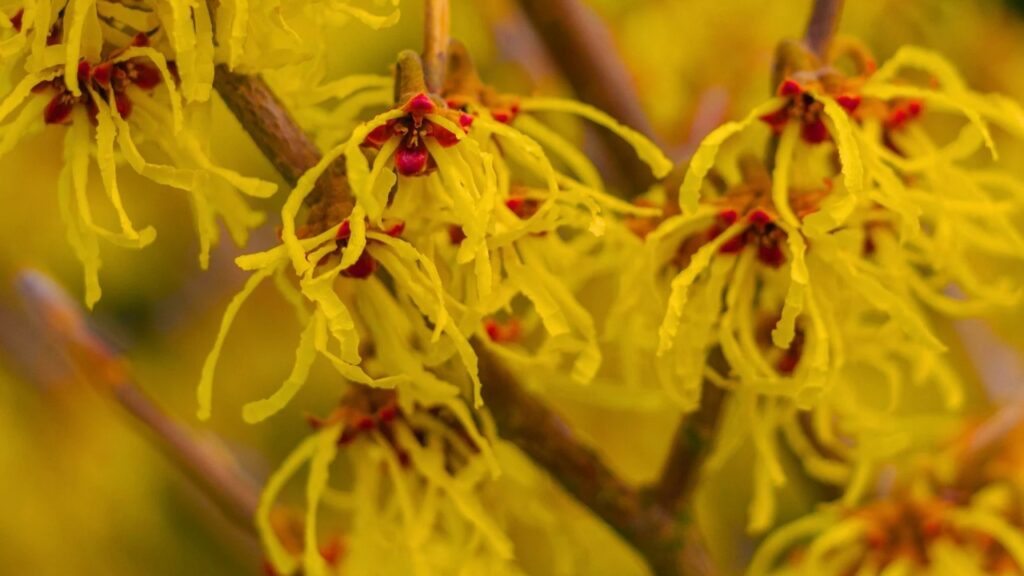
Witch hazel is a unique and colorful plant that is recognized for its distinctive ribbon-like petals, which can be yellow, orange, red, or maroon.
These blooms look like spider webs and add a sensory aspect to the winter landscape.
Loamy, well-drained soil that is somewhat acidic rather than neutral is ideal for witch hazel growth. It can tolerate a broad variety of pH levels and thrives in both full sun and moderate shade. Regular watering is essential, especially while plants are first sprouting and during dry times.
To encourage healthy growth and flowering, apply a slow-release, balanced fertilizer early in the spring. It is essential to fertilize.
Pruning is necessary to remove dead or damaged branches and maintain the plant’s shape. Witch hazel is hardy in USDA zones 3 through 8, thus it can be cultivated in a range of conditions.
Witch hazel’s open, vase-shaped growth habit adds vertical appeal to the winter garden, breaking up the monotony of flat, inactive landscapes.
Its early flowers attract attention and serve as a focus point in winter gardens because of its eye-catching hues and distinctive floral structure.
The ribbon-like petals provide complexity and depth to landscape design. Witch Hazel goes nicely with early spring bloomers and other winter interest plants. It looks nice in mixed shrub borders or as a specimen plant in garden beds.
Cyclamen
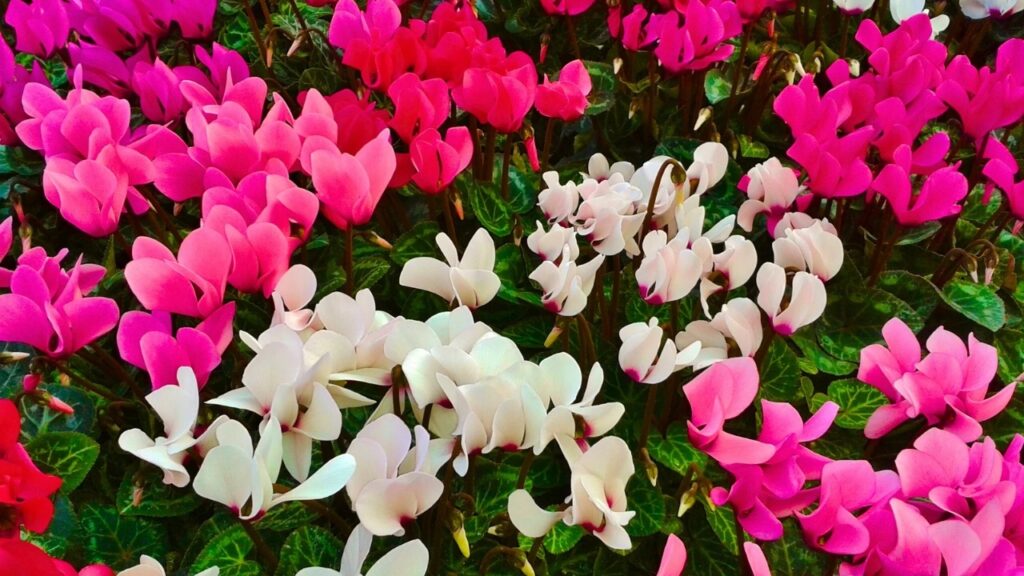
Cyclamen coum is a winter blooming perennial that is valued for its beautiful flowers and attractive leaves. There are several hybrids and variants of it, including “Pink,” “White,” “Red,” “Purple,” and “Silver Leaf.” Cyclamen coum prefers well-drained soil that is high in organic matter and grows in USDA zones 4–8.
It thrives in neutral to slightly acidic soil and needs good drainage. Plant one to two inches deep, leaving a little room at the top to prevent rot. Cyclamen coum is hardy in USDA zones 4–8 and can withstand cold temperatures and frost.
Cyclamen coum can be planted in shaded locations, borders, edging plants, containers, forest settings, rock gardens, and under trees or shrubs. Its delicate flowers and beautiful leaves make it a versatile plant that may be utilized to give beauty and interest to winter gardens.
With the right care and placement, it may thrive and bring some color to otherwise dull settings. If cyclamen cum is planted and maintained properly, it may bring a splash of color to otherwise dull settings.
Winter Aconite
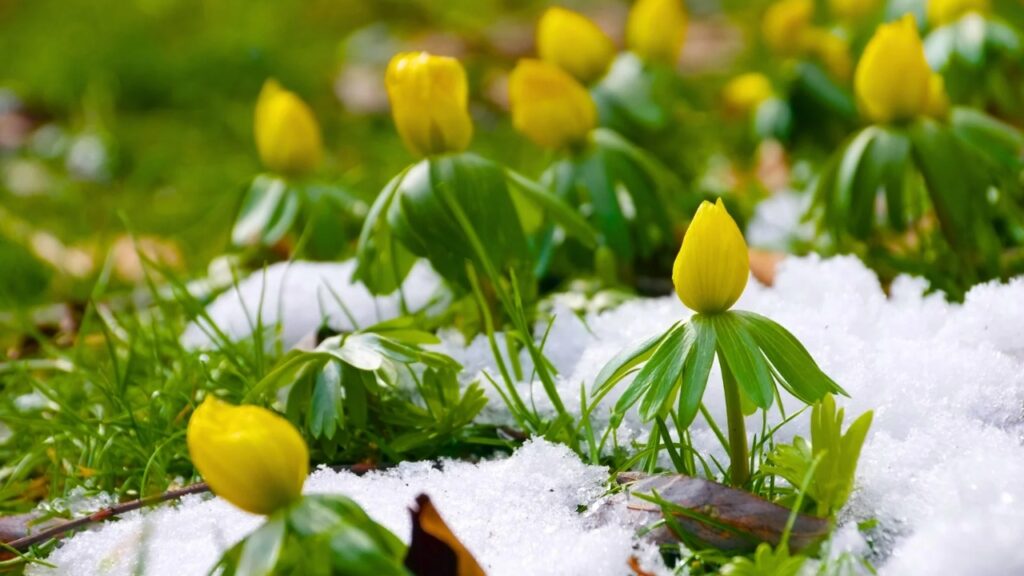
The bright yellow blooms of the beautiful perennial winter aconite, which bloom in late winter or early spring, are its most famous feature. The plant spreads and grows to a height of 4 to 6 inches as it gets more organic.
Although this depends on the climate and weather, it usually blooms in late January or early March.
Humus-rich, well-drained soil that can withstand both full sun and partial shade is ideal for winter aconite growth. Although it may grow in many different climates, USDA zones 4 through 8 are the best for it.
For use in beds or borders, winter aconite can be found naturally in forest gardens or under deciduous trees. Plant in groups or drifts to create a gorgeous golden carpet when the blooms bloom before the trees completely leaf out.
Use it under shrubs and along the margins of bigger garden beds, or in mixed flower beds with other early bloomers like crocuses, snowdrops, and hellebores. On a smaller scale, Winter Aconite can be grown in pots with sufficient drainage and potting mix that drains correctly.
With its vivid yellow blooms and early bloom period, winter aconite is a beautiful addition to any winter garden, providing much-needed color and intrigue during the colder months.
Mahonia
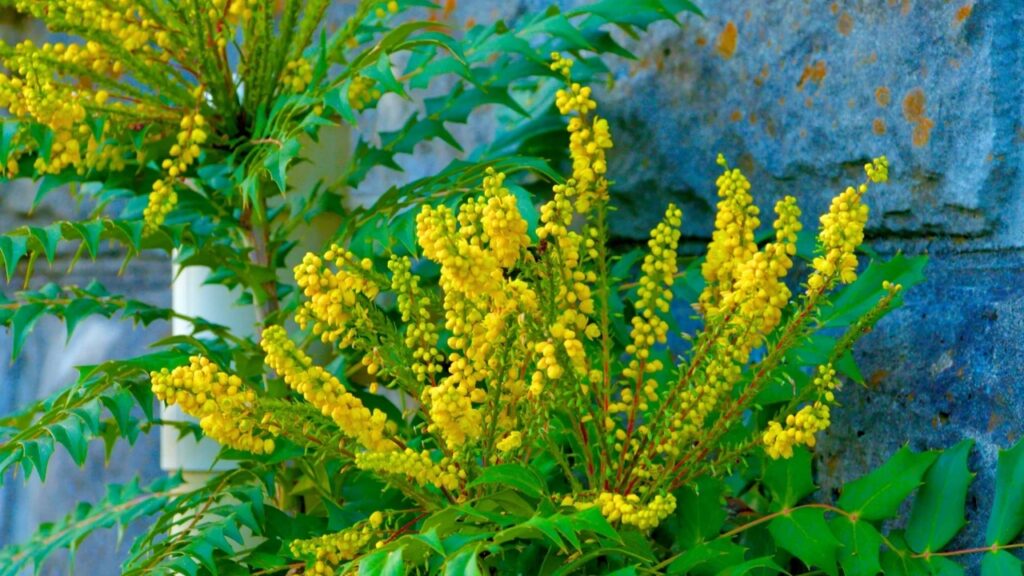
The Oregon grape, or mahonia, is an evergreen shrub with vivid yellow foliage and blossoms. It is valued for its year-round appeal and is a member of the Berberidaceae family.
Mahonia shrubs can reach a height of ten feet and feature leathery, glossy leaves that mimic holly leaves.
They draw pollinators like bees and butterflies. Loamy, well-drained soil with a pH between slightly acidic and neutral is ideal for the plant’s growth. Watering must be done frequently, but not excessively. Light trimming is recommended to shape the plant, and fertilization is essential for good growth and flowering.
Mahonias can be grown in USDA zones 5–9. Winter gardens benefit greatly from the color and texture that Mahonia brings, which contrasts sharply with vistas of ice or snow.
It’s also a fantastic choice for privacy screens, informal hedges, and garden bed backdrops. Wildlife benefits from mahonia, particularly during the winter months when its aromatic blossoms draw pollinators and produce dark blue, grape-like berries.
Blue Spruce
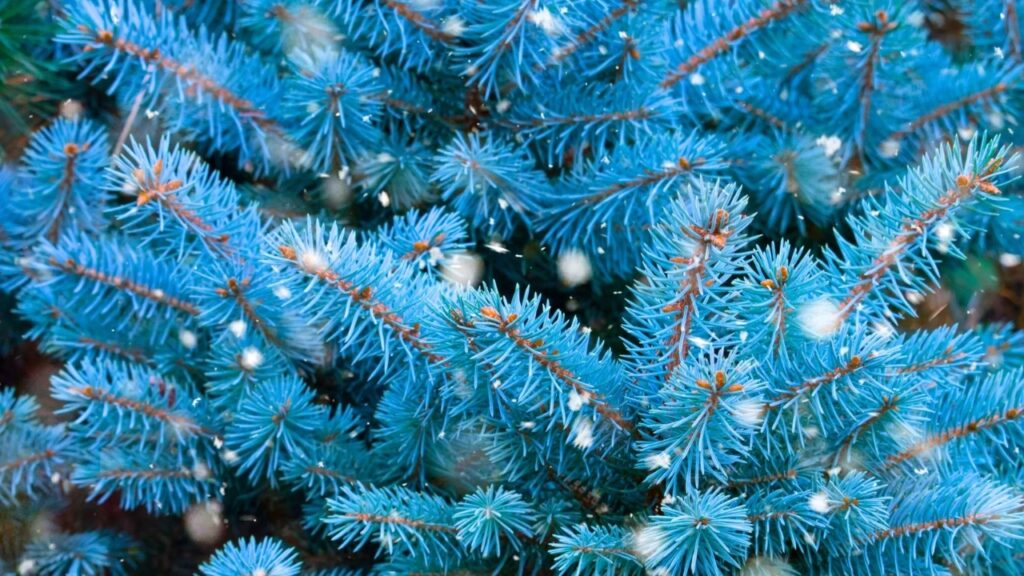
One of the most beautiful winter plants is the blue spruce tree. It is suitable for much of the United States because it is hardy in Zones 2–7, in addition to looking lovely when covered in snow. This tree makes an excellent windscreen, soundscreen, and sightscreen and enjoys full sun. Because insecticides might remove the needle covering that gives the blue spruce its color, use caution when applying them to this tree.
Get Your Garden Ready for Winter
Plant bulbs with springtime blooms.
Remove any dead leaves or withering plants.
Empty irrigation systems and garden hoses to prevent water from freezing inside.
Reduce perennials after the first fatal frost.
Note: You risk depriving your plant of the nutrients it needs to survive the winter if you do this too soon.
To give your garden a winter boost of nutrients, spread compost throughout it. Here’s a tip: compost the leaves you rake from your yard.
In order to know where not to plant in the spring, label your garden.
Advice: Use a permanent marker to write the names of the plants on popsicle sticks, then insert them into the ground.
To shield the plants from severe weather, mulch the garden just before the first freeze.
Advice: Don’t start too soon. Mice might settle in the mulch and eat your plants if you do. Allow the mice time to locate alternative winter residences.

